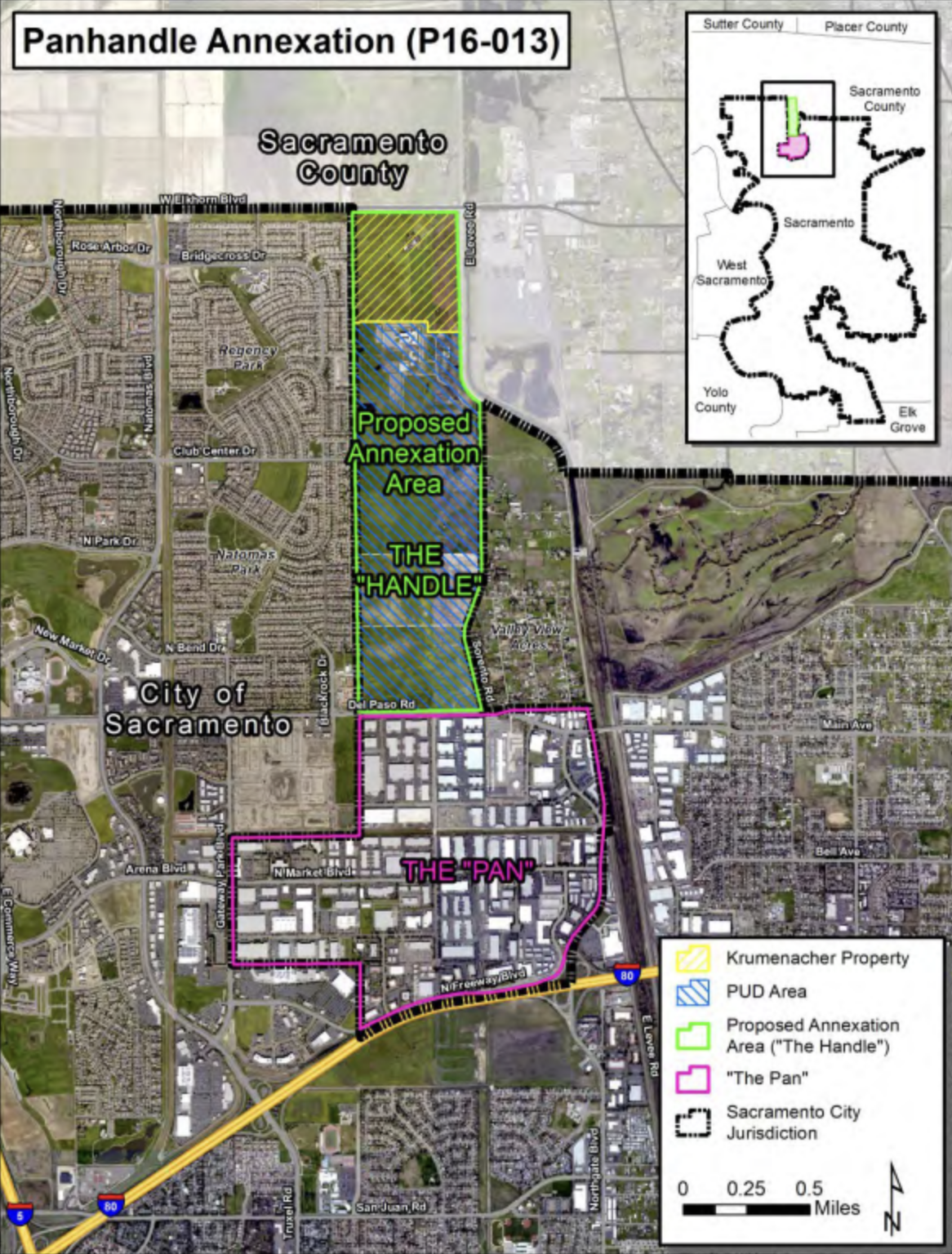Rio Linda's tale of predatory annexation
Rio Linda Online posted a story recently about an investment firm acquiring land for new housing. While the need for new housing is clear, the backstory about this acquisition is a good example of how big cities can steamroll nearby unincorporated communities. Let's start with a quote from the Rio Linda Online article:
The property, formerly an unincorporated area of Sacramento County, was annexed by the City of Sacramento in 2018 at a great cost to the Rio Linda Elverta Recreation and Parks District.John Todd in "Developer Acquires large portion of Panhandle Area", Rio Linda Online, May 4, 2024 {editor's note: the annexation actually took place in 2019}
The long story short is that in 2018 the City of Sacramento pushed hard on the Sacramento County Local Agency Formation Commission (SacLAFCO) to get the area - known locally as the "pan" and the "panhandle" - annexed into the City of Sacramento. The push was easy for the City of Sacramento, which dominates the SacLAFCO Board. SacLAFCO eventually approved the annexation of the "panhandle". The "pan" was left unincorporated because the land owners of the "pan" - an industrial/commercial area that had resulted from Sacramento County's lax land use decisions decades ago - had not wanted to be subjected to control by the City of Sacramento. So SacLAFCO OKed the annexation of the largely unimproved "panhandle" that developers hungered for and created an island of unincorporated territory (the "pan") surrounded by the incorporated City of Sacramento. That decision was bad enough; LAFCOs are supposed to eliminate unincorporated islands, not create them. Worse, though, was how the SacLAFCO decision hurt the Rio Linda Elverta Recreation and Park District (RLERPD).
The notion that the land needed to be developed was not the issue. Rather, it was the insistence by the City of Sacramento that the area slated for development should be removed from the jurisdiction of the RLERPD. The City claimed it could do a better job of providing recreation and park services to the homes once the land was developed. SacLAFCO did the City's bidding and detached the area from the RLERPD, thereby removing it from the park district's tax base. And that was problematic because SacLAFCO, which performs Municipal Service Reviews of special districts like the RLERPD, had already found that the RLERPD provided efficient and adequate services to its customers within its service territory and that the Sphere of Influence - which included both developed and undeveloped land - would remain coterminous with the district's boundaries. Yet, when SacLAFCO approved the City of Sacramento's request to annex the "panhandle", it seemed to overlook its role of analyzing the adequacy of services provided. The situation in 2018 (and since then) was one in which the RLERPD 's recreation and park services were efficient and adequate, whereas the City of Sacramento's were inconsistent and generally inadequate. Unlike the RLERPD, the City of Sacramento has a long history of deferred maintenance of parks. Within two years of the SacLAFCO "panhandle" annexation decision, the City's park maintenance deficit had grown to $128 million. By 2021, even though the City had allocated $5 million to park maintenance, it was determined that it would take 24 years to "catch up". New projects and new maintenance requirements going forward would only add to the burden. So the notion that replacing the provider of efficient and adequate park and recreation services with a service provider that had a track record of failure just did not add up. Further, since SacLAFCO had completed a Municipal Service Review of the RLERPD and concluded the services provided were efficient and adequate, but it had not (and to this day still has not) conducted a Municipal Service Review of the City of Sacramento's delivery of those same services, the decision to hand off the service delivery requirement to the City of Sacramento was unsupported and speculative.
The City of Sacramento's annexation of the "panhandle" was thus a Predatory Annexation. SacLAFCO's decision then was a political decision, one biased in favor of the big city that exerts power within the LAFCO board. Though, as required by law, it stipulated a revenue sharing agreement between the City and the RLERPD, SacLAFCO recommended only one tenth the amount requested by the RLERPD. The County Board of Supervisors, which is also heavily influenced by the City of Sacramento, went along with SacLAFCO and approved the minimal revenue transfer. The annexation decision demonstrated SacLAFCO's inability to make wise decisions about how best to deliver municipal service. Unfortunately, SacLAFCO's built-in favoritism towards its largest city and/or power base is not an isolated instance; there are some other LAFCOs in California that also act that way. California (un)Incorporated would prefer that annexation decisons should be respectful towards unincorporated communities. LAFCOs should not be rubber stamps for existing power bases. We believe that the Cortese-Knox-Hertzberg Act, Section 56000 et seq of the CA Government Code, should stress LAFCO's traditional purpose of controlling urban sprawl into areas where where extension of services would be inefficient, expensive, or ill-timed.

